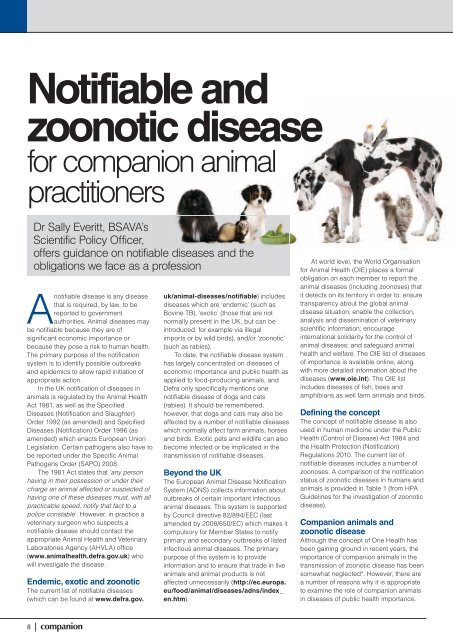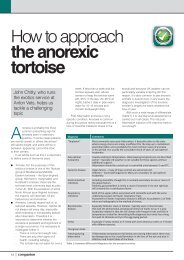Companion May 2012 - BSAVA
Companion May 2012 - BSAVA
Companion May 2012 - BSAVA
Create successful ePaper yourself
Turn your PDF publications into a flip-book with our unique Google optimized e-Paper software.
Notifiable and<br />
zoonotic disease<br />
for companion animal<br />
practitioners<br />
Dr Sally Everitt, <strong>BSAVA</strong>’s<br />
Scientific Policy Officer,<br />
offers offers guidance on notifiable diseases and the<br />
obligations we face as a profession<br />
A<br />
notifiable disease is any disease<br />
that is required, by law, to be<br />
reported to government<br />
authorities. Animal diseases may<br />
be notifiable because they are of<br />
significant economic importance or<br />
because they pose a risk to human health.<br />
The primary purpose of the notification<br />
system is to identify possible outbreaks<br />
and epidemics to allow rapid initiation of<br />
appropriate action.<br />
In the UK notification of diseases in<br />
animals is regulated by the Animal Health<br />
Act 1981, as well as the Specified<br />
Diseases (Notification and Slaughter)<br />
Order 1992 (as amended) and Specified<br />
Diseases (Notification) Order 1996 (as<br />
amended) which enacts European Union<br />
Legislation. Certain pathogens also have to<br />
be reported under the Specific Animal<br />
Pathogens Order (SAPO) 2008.<br />
The 1981 Act states that ‘any person<br />
having in their possession or under their<br />
charge an animal affected or suspected of<br />
having one of these diseases must, with all<br />
practicable speed, notify that fact to a<br />
police constable’. However, in practice a<br />
veterinary surgeon who suspects a<br />
notifiable disease should contact the<br />
appropriate Animal Health and Veterinary<br />
Laboratories Agency (AHVLA) office<br />
(www.animalhealth.defra.gov.uk) who<br />
will investigate the disease.<br />
Endemic, exotic and zoonotic<br />
The current list of notifiable diseases<br />
(which can be found at www.defra.gov.<br />
8 | companion<br />
uk/animal-diseases/notifiable) includes<br />
diseases which are ‘endemic’ (such as<br />
Bovine TB), ‘exotic’ (those that are not<br />
normally present in the UK, but can be<br />
introduced, for example via illegal<br />
imports or by wild birds), and/or ‘zoonotic’<br />
(such as rabies).<br />
To date, the notifiable disease system<br />
has largely concentrated on diseases of<br />
economic importance and public health as<br />
applied to food-producing animals, and<br />
Defra only specifically mentions one<br />
notifiable disease of dogs and cats<br />
(rabies). It should be remembered,<br />
however, that dogs and cats may also be<br />
affected by a number of notifiable diseases<br />
which normally affect farm animals, horses<br />
and birds. Exotic pets and wildlife can also<br />
become infected or be implicated in the<br />
transmission of notifiable diseases.<br />
Beyond the UK<br />
The European Animal Disease Notification<br />
System (ADNS) collects information about<br />
outbreaks of certain important infectious<br />
animal diseases. This system is supported<br />
by Council directive 82/894/EEC (last<br />
amended by 2008/650/EC) which makes it<br />
compulsory for Member States to notify<br />
primary and secondary outbreaks of listed<br />
infectious animal diseases. The primary<br />
purpose of this system is to provide<br />
information and to ensure that trade in live<br />
animals and animal products is not<br />
affected unnecessarily (http://ec.europa.<br />
eu/food/animal/diseases/adns/index_<br />
en.htm).<br />
At world level, the World Organisation<br />
for Animal Health (OIE) places a formal<br />
obligation on each member to report the<br />
animal diseases (including zoonoses) that<br />
it detects on its territory in order to: ensure<br />
transparency about the global animal<br />
disease situation; enable the collection,<br />
analysis and dissemination of veterinary<br />
scientific information; encourage<br />
international solidarity for the control of<br />
animal diseases; and safeguard animal<br />
health and welfare. The OIE list of diseases<br />
of importance is available online, along<br />
with more detailed information about the<br />
diseases (www.oie.int). The OIE list<br />
includes diseases of fish, bees and<br />
amphibians as well farm animals and birds.<br />
Defining the concept<br />
The concept of notifiable disease is also<br />
used in human medicine under the Public<br />
Health (Control of Disease) Act 1984 and<br />
the Health Protection (Notification)<br />
Regulations 2010. The current list of<br />
notifiable diseases includes a number of<br />
zoonoses. A comparison of the notification<br />
status of zoonotic diseases in humans and<br />
animals is provided in Table 1 (from HPA<br />
Guidelines for the investigation of zoonotic<br />
disease).<br />
<strong>Companion</strong> animals and<br />
zoonotic disease<br />
Although the concept of One Health has<br />
been gaining ground in recent years, the<br />
importance of companion animals in the<br />
transmission of zoonotic disease has been<br />
somewhat neglected*. However, there are<br />
a number of reasons why it is appropriate<br />
to examine the role of companion animals<br />
in diseases of public health importance.



